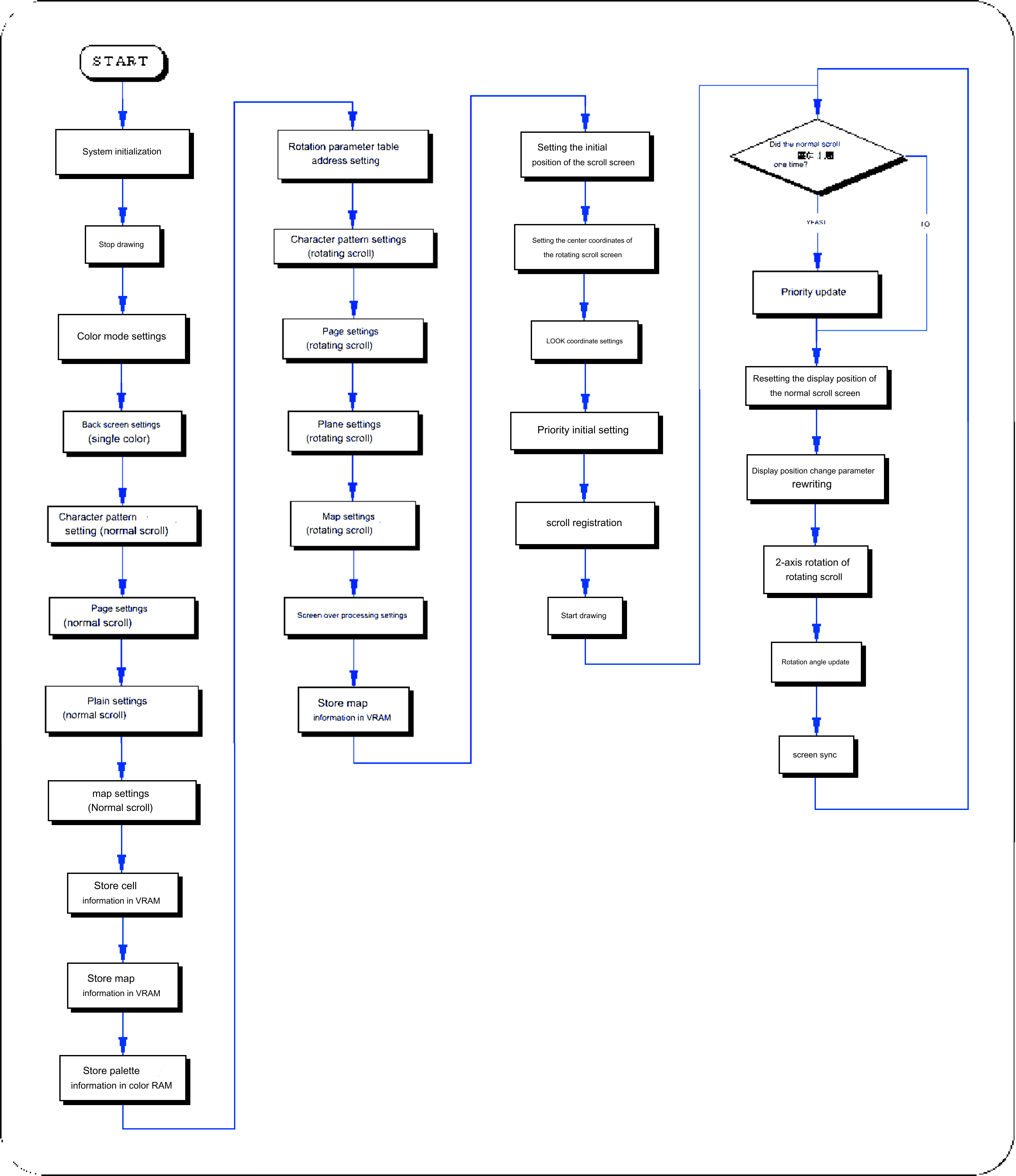8-11. Priority
Figure 8-28 Priority image
Assign a value from 0 to 7 called the priority number to the parameter.
The higher the priority number, the closer the scroll surface will be drawn.
Also, if 0 is specified, the scroll surface is treated as transparent and is not actually drawn.
Please refer to the figure below for priorities when assigning the same priority number to multiple surface types.
● Priority when priority numbers are equal ●SPRITE> RBG0> NBG0> NBG1> NBG2> NBG3
High (front) ←−−−−−−−−−−−→low (back)
Note) POLYGON is included in SPRITE.
In addition, in the default state of SGL, priorities are assigned to each drawing surface as follows.
| priority number | ||||||||
|---|---|---|---|---|---|---|---|---|
| 7 | 6 | 5 | 4 | 3 | 2 | 1 | 0 | |
| drawing surface | NBG0 | SPRITE | SPRITE | RGB0 | NBG1 | NBG2 | NBG3 | Not set |
The following sample program (Listing 8-9) actually uses the SGL library functions "slPriorityNbg0~3,Rbg0" to implement scroll priority processing.
Listing 8-9 sample_8_11: Scroll display priority
/*------------------------------------------------ ----------------------*/
/* Scroll Priority Change */
/*------------------------------------------------ ----------------------*/
#include "sgl.h"
#include "ss_scroll.h"
#define NBG1_CEL_ADR ( VDP2_VRAM_B1 + 0x02000 )
#define NBG1_MAP_ADR ( VDP2_VRAM_B1 + 0x12000 )
#define NBG1_COL_ADR ( VDP2_COLRAM + 0x00200 )
#define RBG0_CEL_ADR VDP2_VRAM_A0
#define RBG0_MAP_ADR VDP2_VRAM_B0
#define RBG0_PAR_ADR ( VDP2_VRAM_A1 + 0x1fe00 )
#define BACK_COL_ADR ( VDP2_VRAM_A1 + 0x1fffe )
void ss_main(void)
{
Uint16 PryNBG = 4 , PryRBG = 1, PryWRK;
FIXED yama_posx = SIPOSX , yama_posy = SIPOSY;
ANGLE ascii_angz = DEGtoANG(0.0);
slInitSystem(TV_320x224,NULL,1);
slTVOff();
slPrint("Sample program 8.11" , slLocate(9,2));
slColRAMMode(CRM16_1024);
slBack1ColSet((void *)BACK_COL_ADR , 0);
slCharNbg1(COL_TYPE_256 , CHAR_SIZE_1x1);
slPageNbg1((void *)NBG1_CEL_ADR , 0 , PNB_1WORD|CN_12BIT);
slPlaneNbg1(PL_SIZE_1x1);
slMapNbg1((void *)NBG1_MAP_ADR , (void *)NBG1_MAP_ADR , (void *)NBG1_MAP_ADR , (void *)NBG1_MAP_ADR);
Cel2VRAM(yama_cel , (void *)NBG1_CEL_ADR , 31808);
Map2VRAM(yama_map, (void *)NBG1_MAP_ADR, 32, 16, 1, 256);
Pal2CRAM(yama_pal , (void *)NBG1_COL_ADR , 256);
slRparaInitSet((void *)RBG0_PAR_ADR);
slCharRbg0(COL_TYPE_256 , CHAR_SIZE_1x1);
slPageRbg0((void *)RBG0_CEL_ADR , 0 , PNB_1WORD|CN_10BIT);
slPlaneRA(PL_SIZE_1x1);
sl1MapRA((void *)RBG0_MAP_ADR);
slOverRA(2);
Map2VRAM(ascii_map ,(void *)RBG0_MAP_ADR , 32 , 4 , 0 , 0);
slScrPosNbg1(yama_posx, yama_posy);
slDispCenterR(toFIXED(160.0) , toFIXED(112.0));
slLookR(toFIXED(128.0) , toFIXED(24.0));
slPriorityNbg1(PryNBG);
slPriorityRbg0(PryRBG);
slScrAutoDisp(NBG0ON | NBG1ON | RBG0ON);
slTVOn();
while( 1 ){
if(yama_posx >= (SX + SIPOSX)) {
PryWRK = PryNBG;
PryNBG = PryRBG;
PryRBG = PryWRK;
slPriorityNbg1(PryNBG);
slPriorityRbg0(PryRBG);
yama_posx = SIPOSX;
}
slScrPosNbg1(yama_posx, yama_posy);
yama_posx += POSX_UP;
slZrotR( ascii_angz );
ascii_angz += DEGtoANG(1.0);
slSynch();
}
}
Flow 8-13 sample_8_11: Scroll display priority

 ★ SGL User's Manual ★ PROGRAMMER'S TUTORIAL
★ SGL User's Manual ★ PROGRAMMER'S TUTORIAL